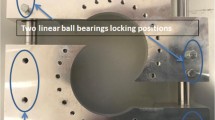Abstract
This work is concerned with a new method for testing material properties under uniform plane-stress conditions by means of a specially designed plane specimen. Photoelastic analysis showed that in the significant section of the specimen it is possible to produce uniform plane stress, with high accuracy, subject to the limitation that the principal stresses are of different signs. An important special case of loading produces pure shear on the significant section. The specimen is of particular importance for fiber-composite testing.
The experimental results presented are encouraging.
Similar content being viewed by others
References
Whitney, J.M., Grimes, G.C. andFrancis, P.H., “Effect of End Attachment on the Strength of Fiber-reinforced Composite Cylinders,”Experimental Mechanics,13 (5),185–192 (May 1973).
Greszczuk, L.B., “New Test Technique for Shear Modulus and Other Elastic Constants of Filamentary Composites,” U.S. Air Force/ASTM Symp. Testing Techniques for Filament Reinforced Plastics, Dayton, OH (Sept. 1966).
Coker, E.G., “An Optical Determination of the Variation of Stress in a Thin Rectangular Plate Subjected to Shear,” Proc. R.S.A.,LXXXVI (1912).
Whitney, J.M., Stansbarger, D.L. andHowell, H.B., “Analysis of the Rail Shear Test—Applications and Limitations,”J. Comp. Mats.,5,24–34 (1971).
Sims, D.F., “In-Plane Shear Stress-Strain Response of Unidirectional Composite Materials,”J. Comp. Mats.,7,124–128 (1973).
Dastin, S., Lubin, G., Munyak, J. and Slobodzinski, A., “Mechanical Properties and Test Techniques for Reinforced Plastic Laminates,” Comp. Mats. Test. & Design, ASTM STP 460, ASTM, 13–26 (1969).
Rosen, B.W., “A Simple Procedure for Experimental Determination of the Longitudinal Shear Modulus of Unidirectional Composites,”J. Comp. Mats.,6,552 (1972).
Arcan, M., “A New Method for the Analysis of Mechanical Properties of Composite Materials,” Int. Cong. Exp. Mech., Los Angeles (In-progress research paper) (May 1973).
Hashin, Z. andRosen, B.W., “The Elastic Moduli of Fiber Reinforced Materials,”J. Appl. Mech.,31,223–232 (1964).Also, Hashin, Z., “Theory of Fiber Reinforced Materials,”NASA CR-1974 (1972).
Author information
Authors and Affiliations
Rights and permissions
About this article
Cite this article
Arcan, M., Hashin, Z. & Voloshin, A. A method to produce uniform plane-stress states with applications to fiber-reinforced materials. Experimental Mechanics 18, 141–146 (1978). https://doi.org/10.1007/BF02324146
Received:
Revised:
Issue Date:
DOI: https://doi.org/10.1007/BF02324146




